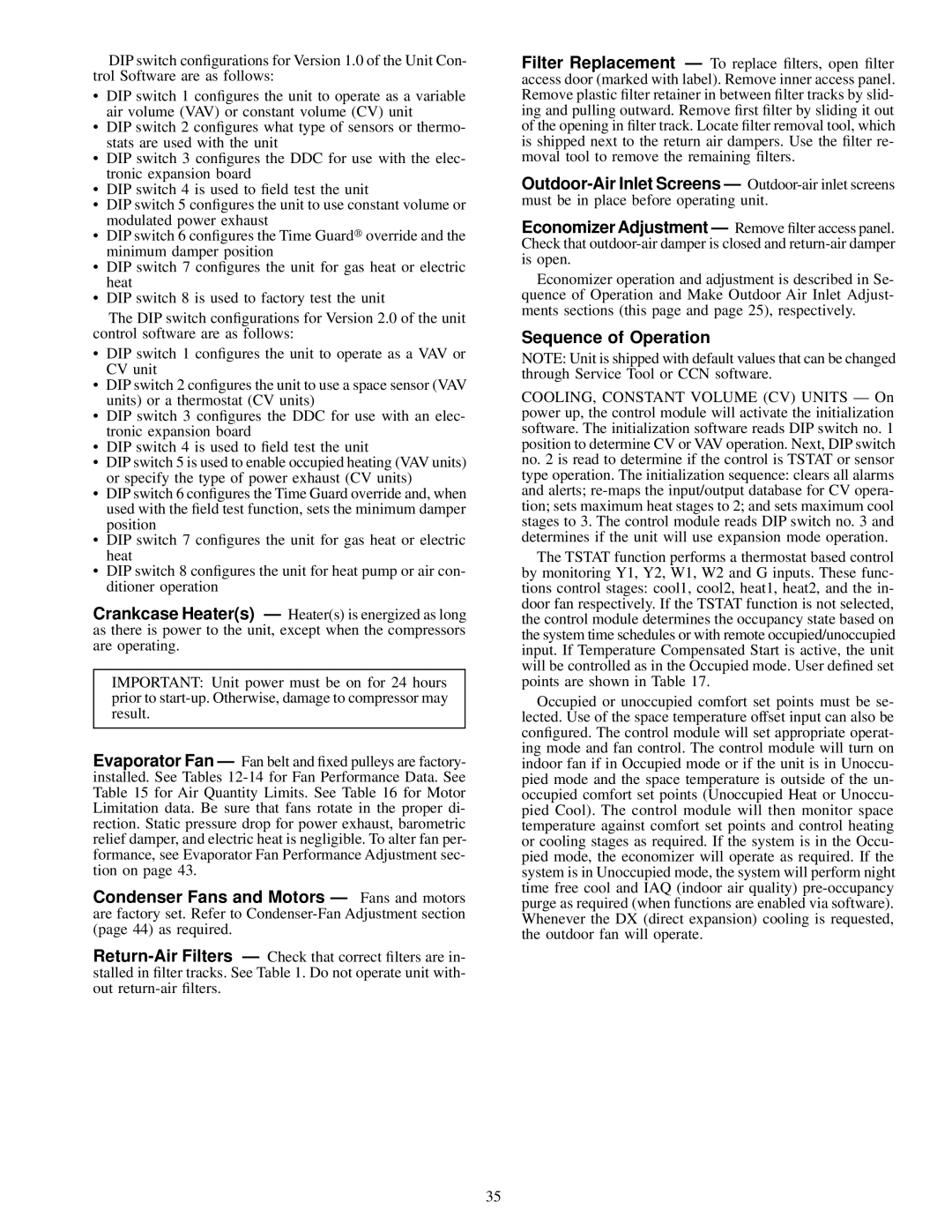
DIP switch con®gurations for Version 1.0 of the Unit Con- trol Software are as follows:
·DIP switch 1 con®gures the unit to operate as a variable air volume (VAV) or constant volume (CV) unit
·DIP switch 2 con®gures what type of sensors or thermo- stats are used with the unit
·DIP switch 3 con®gures the DDC for use with the elec- tronic expansion board
·DIP switch 4 is used to ®eld test the unit
·DIP switch 5 con®gures the unit to use constant volume or
modulated power exhaust
· DIP switch 6 con®gures the Time Guard override and the minimum damper position
·DIP switch 7 con®gures the unit for gas heat or electric heat
·DIP switch 8 is used to factory test the unit
The DIP switch con®gurations for Version 2.0 of the unit control software are as follows:
·DIP switch 1 con®gures the unit to operate as a VAV or CV unit
·DIP switch 2 con®gures the unit to use a space sensor (VAV units) or a thermostat (CV units)
·DIP switch 3 con®gures the DDC for use with an elec- tronic expansion board
·DIP switch 4 is used to ®eld test the unit
·DIP switch 5 is used to enable occupied heating (VAV units) or specify the type of power exhaust (CV units)
·DIP switch 6 con®gures the Time Guard override and, when used with the ®eld test function, sets the minimum damper position
·DIP switch 7 con®gures the unit for gas heat or electric heat
·DIP switch 8 con®gures the unit for heat pump or air con- ditioner operation
Crankcase Heater(s) Ð Heater(s) is energized as long as there is power to the unit, except when the compressors are operating.
IMPORTANT: Unit power must be on for 24 hours prior to
Evaporator Fan Ð Fan belt and ®xed pulleys are factory- installed. See Tables
Condenser Fans and Motors Ð Fans and motors are factory set. Refer to
Filter Replacement Ð To replace ®lters, open ®lter access door (marked with label). Remove inner access panel. Remove plastic ®lter retainer in between ®lter tracks by slid- ing and pulling outward. Remove ®rst ®lter by sliding it out of the opening in ®lter track. Locate ®lter removal tool, which is shipped next to the return air dampers. Use the ®lter re- moval tool to remove the remaining ®lters.
Economizer Adjustment Ð Remove ®lter access panel. Check that
Economizer operation and adjustment is described in Se- quence of Operation and Make Outdoor Air Inlet Adjust- ments sections (this page and page 25), respectively.
Sequence of Operation
NOTE: Unit is shipped with default values that can be changed through Service Tool or CCN software.
COOLING, CONSTANT VOLUME (CV) UNITS Ð On power up, the control module will activate the initialization software. The initialization software reads DIP switch no. 1 position to determine CV or VAV operation. Next, DIP switch no. 2 is read to determine if the control is TSTAT or sensor type operation. The initialization sequence: clears all alarms and alerts;
The TSTAT function performs a thermostat based control by monitoring Y1, Y2, W1, W2 and G inputs. These func- tions control stages: cool1, cool2, heat1, heat2, and the in- door fan respectively. If the TSTAT function is not selected, the control module determines the occupancy state based on the system time schedules or with remote occupied/unoccupied input. If Temperature Compensated Start is active, the unit will be controlled as in the Occupied mode. User de®ned set points are shown in Table 17.
Occupied or unoccupied comfort set points must be se- lected. Use of the space temperature offset input can also be con®gured. The control module will set appropriate operat- ing mode and fan control. The control module will turn on indoor fan if in Occupied mode or if the unit is in Unoccu- pied mode and the space temperature is outside of the un- occupied comfort set points (Unoccupied Heat or Unoccu- pied Cool). The control module will then monitor space temperature against comfort set points and control heating or cooling stages as required. If the system is in the Occu- pied mode, the economizer will operate as required. If the system is in Unoccupied mode, the system will perform night time free cool and IAQ (indoor air quality)
35
